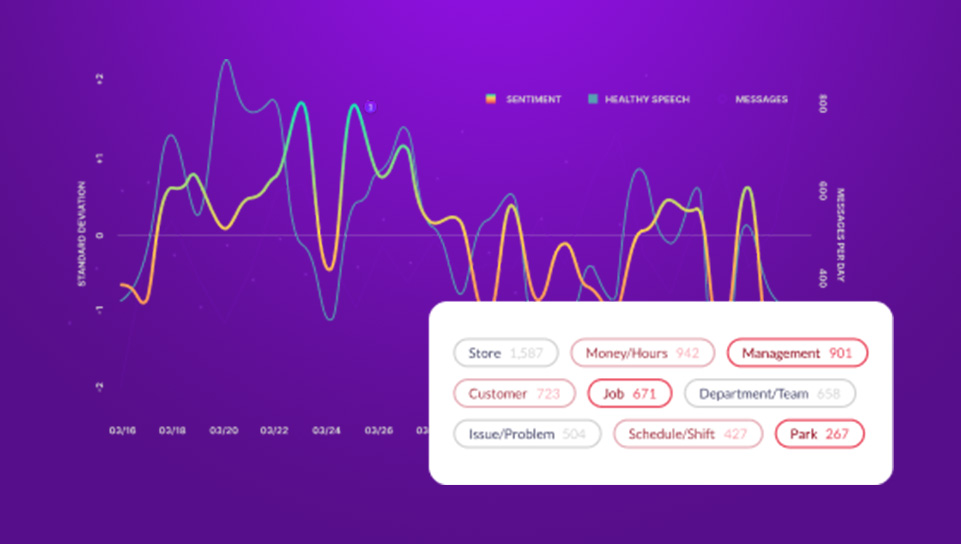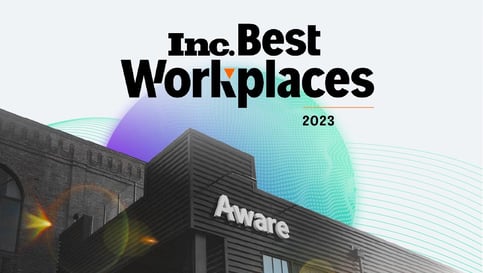Measuring Employee Engagement? Here's How to Enhance Employee Sentiment Scores
by Aware
Employee engagement is one of the many reasons you love your job. It’s why your team members love their jobs, too. Staying on par with the corporate mission, ensuring clear communication from the top down, feeling valued at work and hearing words of affirmation and appreciation make all of us work harder.
Though employee engagement might look different now, it’s important to understand the power it still carries in your organization. With platforms like Aware, you can go beyond the sentiment scores and delve deeper into areas of opportunity for increasing employee engagement in your organization. Here’s everything you need to know about accurately measuring employee sentiment to increase workplace engagement.
What is Employee Engagement?
Employee engagement describes the relationship between an organization and its employees. It describes the extent to which employees feel passionate about their jobs, feel committed to the organization, and go the extra mile at work. Employee engagement is not the same as employee sentiment, although the two are related.
2 Key Flaws of the Annual Employee Survey
When your employees talk, do you listen?
Relying on annual employee surveys and sentiment scores won’t provide enough data to effectively manage today’s culture-first work environment. True engagement involves creating experiences employees feel part of and consulting them regularly. The annual employee survey has two core flaws that render the standard practice less effective and actionable than frequent check-ins:
1. Real-time decisions require real-time data.
Yearly surveys provide insight from a single moment in time. Likewise, as time goes on, your employees’ sentiment may change. For example, a survey distributed soon after a company culture event may yield very different results than the same survey after widespread layoffs. Over the span of a year, the accuracy of your survey inevitably diminishes.
If you are making informed decisions on old information, you are trying to solve new problems with old data.
- Greg Moran, COO, Aware
2. Surveys often elicit biased and inaccurate responses.
Annual surveys provide skewed results for many reasons, some of which include:
- Culture surveys often tie directly or indirectly into employee evaluations and bonus pay
- Team leaders may encourage team members to respond positively to gain additional department dollars
- Some surveys include confusing language, leading to potential question misinterpretations
- The survey may not ask questions in a way that identifies an accurate pulse of employee sentiment towards the workplace
- The best performing employees may skip the survey to invest time elsewhere, thus only presenting data from average- or low-performing employees, skewing results
- Employees may not trust survey result anonymity
Take a moment to consider that, though long, this list is not exhaustive. We know what you’re thinking: If relying on annual survey scores doesn’t cut it anymore, how will my organization get the inside scoop on employees’ thoughts, ideas, feelings and opinions?
Uncovering Valuable Employee Sentiment Insights from the Digital Workplace
Communication and collaboration platforms like Slack, Yammer, Workplace from Meta and Microsoft Teams offer a wealth of information and insights from your employees. They also give human resource teams inside access to better understand employee sentiment in real time.
Let’s say your company is seeking a new VP of Marketing. Several current employees apply for the position in addition to new candidates. Ultimately, you hire an outside candidate who you feel is most qualified for the position. However, your employees are upset as they feel let down, overlooked and overall unappreciated. Unless your annual employee survey happens soon after this event, you may never know how unhappy your employees are or if they intend to relocate in the upcoming months.
With collaboration platforms, you can analyze aggregate conversations in real time and explore common themes to best understand your team, how to meet their needs, and how to target messages toward frequently discussed topics. By using an insights solution that leverages qualitative insights based on natural language processing (NLP) models in tandem with standard quantitative insights, you can accurately measure employee sentiment and address areas of concern before they turn into big problems.
2 Vital Components of Successful Employee Engagement
There are two elements to consider when discussing employee engagement: the organization and the team. The way employees communicate between these two groups can vary greatly.
Organization Engagement
How often do the leaders of your company interact with lower-level employees? When measuring employee engagement, it’s helpful to take a look at how they interact with management, and vice versa.
Begin by looking at the ways your managers motivate employees. If they’re building strong relationships and developing cohesive teams, give them a pat on the back. Strong leadership creates solid teams. Likewise, if your employees feel comfortable and confident around management, they’re more likely to form healthy and meaningful connections with their colleagues. All of these pieces fit into the employee engagement puzzle because, if everyone gets along and works well together, employees feel more fulfilled in their roles and bring better attitudes to work.
Team Engagement
Effective teamwork is a cornerstone of employee engagement. Thus, team engagement plays an important role in your company’s culture. Do your employees understand your organization’s trajectories and how working together contributes to its success? When employees feel valued, they produce their best work.
When working from home, however, it can be difficult for teams to understand how their work fits into the bigger picture. Help them feel seen and understood with recognition, feedback, clear communication and by simply saying, “thank you.” When clear expectations are defined, the entire enterprise benefits. Likewise, when teams experience engagement, they’re more likely to generate new ideas, gain new perspectives, play into their strengths and boost productivity.
A culture of engagement never goes out of style—do everything you can to preserve it. Even from home, encourage employees to maintain their relationships and connections via collaboration platforms. Leverage these platforms to motivate, empower, and challenge employees. Provide your staff with a safe platform to continue these conversations, host meetings and feel like part of the team, and maintain the momentum of your organization’s culture.
The Importance of Listening to Your People in Real Time
The annual employee survey doesn’t cut it in today’s fast-paced workplace. You need to understand your organization in real time to take effective action that protects and nurtures your company culture. That means accessing real-time, contextual insights into employee sentiment and organizational health.
Interacting regularly with people from all levels and building comfort zones where they feel safe expressing themselves honestly is vital. The more you understand the attitudes, thoughts and feelings your employees bring to work each day, the better leadership can support them.
Measure and Understand Employee Engagement with Aware Spotlight
Measure employee engagement and interaction with a qualitative insights solution like Aware’s Spotlight.
- Leverage features like Top Keywords and Related Themes to understand hot topics in your organization.
- Understand the sentiment and conversation health of your entire digital workplace, as well as individual groups,
Aware integrates seamlessly with Microsoft Teams, Slack, Workplace from Meta and Yammer to give you real-time insights on employee engagement and organizational health from your employees’ everyday communications.
Schedule a 30-minute demo today.








